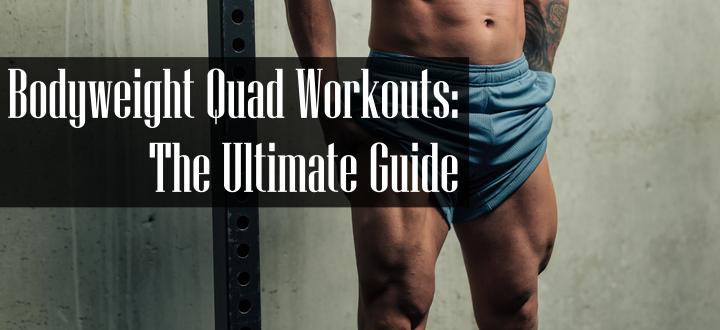While many people associate quad workouts with heavy weights, it’s actually possible to build strong quads with just your body weight.
The fact is:
Calisthenics is a great way to improve your fitness and can be done anywhere without special equipment. They also offer several benefits beyond building muscle – such as improved balance, stability, and mobility.
Today I’ll show you the best bodyweight quad workouts – and mix it all to bring you a super effective quad workout program you can start following immediately!
Contents
5 Super Effective Bodyweight Quad Workouts – and How to Do Them Properly
Bodyweight Squats
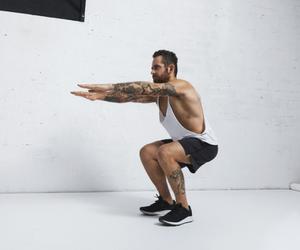
Bodyweight squats are a classic exercise that can help strengthen your quads, glutes, and hamstrings – as well as improve your overall lower body mobility. Here’s how to perform a bodyweight squat:
- Stand with your feet shoulder-width apart, and your toes pointed slightly outward.
- Place your hands on your hips or in front of you for balance.
- Bend your knees and lower your hips down and back as if sitting in a chair.
- Keep your chest lifted and your core engaged as you lower down.
- Stop when your thighs are parallel to the ground – or lower if possible.
- Push through your heels to stand back up to the starting position.
Repeat for 10-15 repetitions or as many as you can do with good form. Rest for 30-60 seconds, then repeat for 2-3 sets.
Variations:
- Narrow stance squats: Place your feet together for a more challenging variation that targets your inner thighs.
- Sumo squats: Place your feet wider than shoulder-width apart and point your toes outward for a wider stance and a greater emphasis on your inner thighs and glutes.
- Jump squats: Add a plyometric component to your squats by jumping explosively as you stand up.
Benefits:
- Strengthens your quads, glutes, and hamstrings
- Improves lower body mobility and stability
- Can be done anywhere, without any special equipment
Incorporating bodyweight squats into your workout routine is a great way to improve your lower body strength and mobility. If you’re new to squats, start with a few repetitions and gradually increase your volume. Remember to keep good form and avoid any pain or discomfort.
Lunges
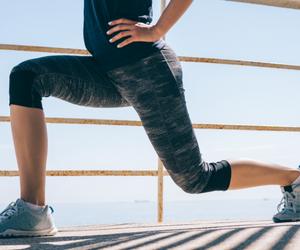
Lunges are another excellent bodyweight exercise for strengthening your quads, as well as your glutes and hamstrings. Here’s how to perform a basic lunge:
- Start by standing up tall with your feet hip-width apart.
- Take a big step forward with your right foot and lower your body until your right thigh is parallel to the ground and your left knee hovers just above the ground.
- Keep your torso upright and your core engaged.
- Push through your right foot to stand back up to the starting position.
- Repeat on the other side, taking a big step forward with your left foot.
Repeat for 10-15 repetitions on each side or as many as you can do with good form. Rest for 30-60 seconds, then repeat for 2-3 sets.
Variations:
- Reverse lunges: Instead of stepping forward, step back with your right foot and lower your body into a lunge. Repeat on the other side.
- Walking lunges: Take several steps forward with each lunge, alternating legs as you go.
- Side lunges: Step out to the side with your right foot and lower your body into a lunge. Repeat on the other side.
Benefits:
- Strengthens your quads, glutes, and hamstrings
- Improves balance and stability
- Increases lower body flexibility and mobility
Incorporating lunges into your workout routine is a great way to target your quads and other lower body muscles. Start with a few repetitions and gradually increase your volume over time, remembering to keep good form and avoid pain or discomfort.
Step-Ups
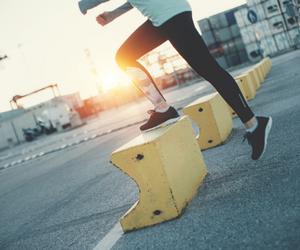
Step-ups are a simple but effective bodyweight exercise that can help you build strong quads and improve your balance and coordination. Here’s how to perform a step-up:
- Find a stable platform or step that is about knee height.
- Stand facing the step with your feet hip-width apart.
- Step onto the platform with your right foot, keeping your left foot on the ground.
- Push through your right foot to stand up tall on the step.
- Step back down with your left foot, then your right foot.
- Repeat, stepping up with your left foot this time.
Repeat for 10-15 repetitions on each side or as many as you can do with good form. Rest for 30-60 seconds, then repeat for 2-3 sets.
Variations:
- Box jumps: Add a plyometric component to your step-ups by jumping up onto the platform instead of stepping.
- Single-leg step-ups: Perform the exercise using only one leg, alternating sides each time.
- Side step-ups: Step up onto the platform from the side instead of facing it.
Benefits:
- Strengthens your quads, glutes, and hamstrings
- Improves balance, coordination, and stability
- Increases lower body flexibility and mobility
Incorporating step-ups into your workout routine is a great way to challenge your quads and improve your lower body fitness. Start with a few repetitions and gradually increase your volume over time, remembering to keep good form and avoid pain or discomfort.
Bulgarian Split Squats
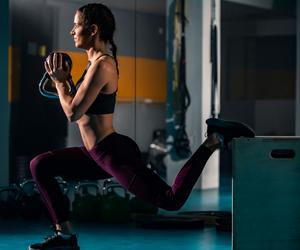
Bulgarian split squats are a challenging bodyweight exercise that can help you build strong quads, glutes, and hamstrings. Here’s how to perform a Bulgarian split squat:
- Find a stable platform or step that is about knee height.
- Stand facing away from the platform with your feet hip-width apart.
- Place the toes of your right foot on the platform behind you, with your heel lifted off the ground.
- Shift your weight onto your left foot and bend your left knee to lower your body into a lunge, keeping your torso upright and your core engaged.
- Keep lowering until your left thigh is parallel to the ground, then push through your left foot to stand back up to the starting position.
- Repeat for 10-15 repetitions on each side or as many as you can do with good form.
Variations:
- Elevated split squats: Increase the height of the platform to make the exercise more challenging.
- Plyometric split squats: Add a jump to the exercise by pushing off the ground with your left foot and switching your leg positions in mid-air.
- Weighted split squats: Hold a dumbbell or other weight in each hand to increase the resistance of the exercise.
Benefits:
- Strengthens your quads, glutes, and hamstrings
- Improves balance, stability, and coordination
- Increases lower body flexibility and mobility
Incorporating Bulgarian split squats into your workout routine can be a great way to add variety and challenge to your bodyweight quad workout. Start with a few repetitions and gradually increase your volume over time, remembering to keep good form and avoid pain or discomfort.
Plyometric Exercises
In addition to the strength-building exercises mentioned earlier, plyometric exercises can be a great way to improve power, explosiveness, and agility in your legs. Plyometrics involve quick, explosive movements that help to activate the fast-twitch muscle fibers in your quads, resulting in improved speed and jumping ability.
Here’s an overview of some plyometric exercises you can try:
- Squat jumps: Start in a squat position, then explosively jump as high as you can, landing back in the squat position.
- Jump lunges: Start in a lunge position, then jump and switch your legs in mid-air, landing in a lunge on the opposite side.
- Box jumps: Stand in front of a sturdy box or bench, then jump onto the box and land softly, stepping back down to the ground.
- Skater jumps: Start in a lateral lunge position, then push off and jump to the other side, landing in a lateral lunge on the opposite side.
- Single-leg hops: Hop forward, backward, or side-to-side on one leg, focusing on quick and explosive movements.
Benefits of Using plyometric exercises for the quads Training:
- Improved power and explosiveness
- Increased speed and jumping ability
- Enhanced athletic performance
- Can be a fun and challenging addition to your workout routine
Example of a Plyometric Exercise Routine for Quads:
- Squat jumps: 2-3 sets of 10-15 reps
- Jump lunges: 2-3 sets of 10-15 reps (5-7 reps per leg)
- Box jumps: 2-3 sets of 10-15 reps
- Skater jumps: 2-3 sets of 10-15 reps (5-7 reps per leg)
- Single-leg hops: 2-3 sets of 30 seconds for each leg
When performing plyometric exercises, it’s important to start with lower intensity and gradually increase as you get stronger and more comfortable with the movements. Plyometrics can be more stressful on your joints and tendons, so proper warm-up and recovery are essential to prevent injury. Always listen to your body and avoid pushing yourself too hard too fast.
Putting It All Together: Sample Bodyweight Quad Workout
Now that you have a variety of exercises to choose from, it’s time to put them together into a comprehensive bodyweight quad workout. Here’s a sample routine to get you started:
1. Warm-up: 5-10 minutes of light cardio (e.g. jogging in place, jumping jacks) and dynamic stretching (e.g. leg swings, walking lunges).
2. Strength-building exercises:
- Bodyweight squats: 3 sets of 10-15 reps
- Bulgarian split squats: 3 sets of 10-15 reps per leg
- Reverse lunges: 3 sets of 10-15 reps per leg
- Single-leg deadlifts: 3 sets of 10-15 reps per leg
3. Plyometric exercises:
- Squat jumps: 2-3 sets of 10-15 reps
- Skater jumps: 2-3 sets of 10-15 reps (5-7 reps per leg)
- Single-leg hops: 2-3 sets of 30 seconds for each leg
4. Burnout finisher:
- Wall sits: Hold for 60-90 seconds, rest for 30 seconds, repeat for 2-3 sets
5. Cool-down: 5-10 minutes of static stretching (e.g. quad stretch, hamstring stretch) and foam rolling.
This workout should take approximately 30-45 minutes, depending on your rest periods and intensity level. Remember to listen to your body and modify the exercises to fit your fitness level and goals. As you get stronger, you can increase the reps or sets of each exercise – or even try more challenging variations.
Final Words
Incorporating bodyweight exercises into your workout routine can be a convenient and effective way to target your quads without needing access to a gym or equipment.
By including a mix of strength-building and plyometric exercises, you can build strength, power, and endurance in your legs while improving your overall fitness.
Try this sample workout or create your own variation, and see how bodyweight training can help you achieve your quad goals.
To learn more about how to build muscle, visit my collection of strength-building articles – PACKED with actionable tips and hacks.
Other Helpful Resources
- Calisthenics Body vs Gym Body: How Do They Differ?
- Will Bodyweight Exercises Build Muscle? 9 Must-Know Benefits of Bodyweight Training
- The Progressive Overload Principle: Definition and Science
- Bodyweight Workouts For Beginners – The Ultimate Guide
- Does Calisthenics Build Muscle? The Beginners ABC to Calisthenics Exercise

